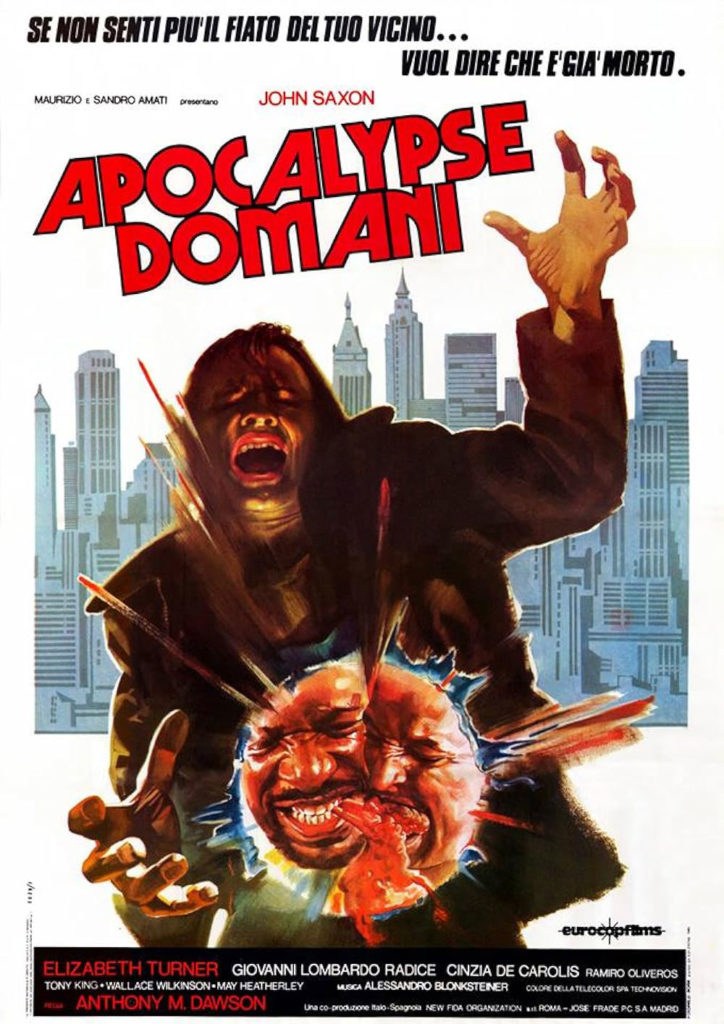The 1970’s and ’80s saw a lot of self-reflection here in the States about the Vietnam War. Not only did we lose, the war was a crime against humanity, resulting in the deaths of millions. We never should have gone into Vietnam, but there has never been much of a mea culpa in popular culture outside of cinema. Even there, every Platoon was rebutted by a Missing in Action.
The Vietnam War is a subject rich for allegory. Cannibal Apocalypse, had it been made by an American filmmaker, might have been one of those films. It comes close. Alas, it’s an Italian horror flick, and writer/director Antonio Margheriti (with the prolific Dardano Sacchetti sharing writing credits) was not interested in an introspective feature on American guilt. It is interesting how close it comes, though, intentionally or not.
Cannibal Apocalypse stars John Saxon as Norman Hooper. In the opening scene, we see Hooper leading a squad of soldiers against Viet Cong guerillas during the war. The attack is generic and brutal, showcasing at once this film’s budgetary limitations and its sense of war. The scene culminates with Hooper finding two American soldiers, Bukowski and Thompson (Giovanni Lombardo Radice and Tony King), being held prisoner in a pit. Something has happened to them, however. They have a newfound taste for human flesh, with Thompson taking a big chunk out of Hooper’s arm.
The film is setting itself up to go in a certain direction in this opening scene. It’s implied that cannibalism is spread by biting, à la zombie flicks. And that is how cannibalism works in this movie. But then the movie flashes forward many years. Hooper is back in the States, living in a nice house. He has a lovely wife, Jane (Elizabeth Turner), who  has a successful career as a television host. Meanwhile, Bukowski and Thompson are hospitalized nearby, being treated for severe PTSD, their proclivities for human flesh forgotten for the moment.
has a successful career as a television host. Meanwhile, Bukowski and Thompson are hospitalized nearby, being treated for severe PTSD, their proclivities for human flesh forgotten for the moment.
Bukowski is declared well enough for a weekend pass from the hospital, but is soon overwhelmed. He calls Hooper for help, but Hooper is too busy cheating on his wife with the teenaged girl from next door (Cinzia De Carolis) to be bothered. Bukowski ends up in a standoff with the police, and gives one a little chomp as he is led away.
Back in the hospital, Bukowski and Thompson attack and bite a nurse (May Heatherly). Over at the police precinct, the cop who was bitten goes on a spree. Meanwhile, Hooper is finally beginning to show the effects of the bite he received many years ago, and now our cast is a group of flesh-hungry cannibals, stalking the streets for new victims. They still have their personalities and intelligences, but they are driven solely by their hunger.
Cannibals in the Streets takes turns following cinema’s loose rules regarding zombies, and then abandons them as needed. That’s fine. These tropes are all made up, anyway. The problem is that Margheriti doesn’t care about consistency in the story. Why does the cannibalism, caused by a virus, as explained in some exposition, go dormant for years after the opening scene? Why does it crop up again at this particular moment? Why does it affect newly bitten characters so quickly? It doesn’t make sense. Get past that, and there’s a good horror film to be seen.
Having devoted so much of this site to bad movies in the last decade, I’ve seen a lot of John Saxon. In general, he will be the most reliable performer in any b-movie he is in. This is not a b-movie, and he carries the film just fine. He was an actor who should have had more prominent roles than he did. It’s to the viewers benefit that he plied his trade in this film.
The real treat in the cast is Wallace Wilkinson as Captain McCoy, the cop who has to stop all the killing. Wilkinson played the character as a gruff hardass who has no patience for nonsense. Whenever this flick needed a one-liner to break up the tension, Wilkinson delivered.
In fact, most of the cast did quite well with the material. Usually there are a lot more duds in a cheap Italian horror flick, but not here. The weakest performer was De Carolis, but viewers don’t have to spend much time with her. The scenes she was in were quite cringey, but that was mostly situational, and not down to her performance.
Cannibals in the Streets is something of a scatterbrained film, with little cohesion in the plot. It’s still an enjoyable watch, and an interesting take on the cannibal subgenre of horror, which the Italians embraced so thoroughly. It’s also a film that is not as strong as its ideas. There is some rich material in the idea of Vietnam vets coming home infected with a strain of cannibalism. Since Margheriti chose not to explore that idea fully, it might have been better to abandon the Vietnam conceit, and find some other origin for his characters. It wouldn’t have been that tall a mountain to climb, as the Vietnam stuff is very much in the periphery.
